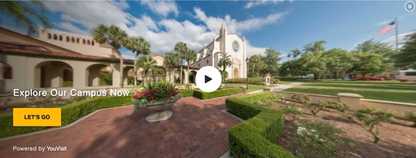An All-Ages Education
October 27, 2017
By Robert Stephens

Preschool and undergraduate studies converge at the new Hume House Child Development & Student Research Center.
The deepest reservoir of energy on the Rollins campus isn’t found in a molecular experiment or in a dorm room stash of Red Bulls. It’s here at Hume House, the new state-of-the-art home of the Department of Psychology’s Child Development & Student Research Center (CDC). For proof, simply step outside to the playground, where undergraduates look on as preschoolers whiz around a butterfly garden, scurry inside a wizard house, and fly through the tomato plants. This frenetic game of chase is just one example of the real-world education taking place at the only laboratory preschool at a private liberal arts college in Florida.
“We use observation as the core skill in psychology,” says Sharon Carnahan, professor of psychology and CDC executive director. “What our undergraduates observe here can be a fulcrum into transforming early education in communities, locally and globally.”
Carnahan first proposed her dream for the ideal CDC 20 years ago. She and CDC Director Diane Terorde-Doyle helped develop architectural plans for the new facility and championed them until Hume House opened in February 2017. The center is a living, breathing realization of a shared vision: a space where preschool and college studies intersect, where 5,050 square feet triple the maximum capacity for teachers, undergrads, and the children from 2 to 5 years of age who represent a full spectrum of abilities. Accelerated learners. Children with Down Syndrome. Students on the autism spectrum. All learning and socializing together.
“We like to think we’re changing lives with psychology,” Carnahan says. “But here we see it working across the campus spectrum. Undergrads from physics, environmental studies, art, and English are asking to come and contribute. Because no matter what field of study you’re in, when a 3-year-old sits on your lap, it changes the way you look at the world.”

Undergrad Classroom
The Nordegren Classroom looks like a typical college learning space, with 24 orderly desks. Look closer. Led by psychology professor Alice Davidson, students delve into topics like the roots of empathy and then step over to a two-way mirror to watch how Billy and Isabella get along during play time. Or they can stroll around the corner to participate on the floor, applying what they’re learning in real time. “There’s no classroom like this in Florida,” says Carnahan.

Preschool Classrooms
The Hume House has three preschool classrooms, each of them larger than the old CDC’s lone classroom. They’re all authentic, with no high-tech, high-cost equipment that would be impossible to replicate in financially challenged communities. For parents (mostly faculty and Rollins staff and students), the extra space means there’s no longer a three-year waiting period to get into the preschool. For undergrads, it’s an opportunity to learn from the teachers and from the children up close.

Observation Rooms
Look straight up in a CDC preschool classroom and you’ll see modest nods to technology—microphones mounted on “clouds.” Undergrads from any Rollins curriculum have the freedom to observe interactions visually and audibly, without being obvious. It’s a valuable tool for field research, even in subjects like math and physics.

The Playground!
This is a work in constant progress, combining the skills and imaginations of maintenance people, groundskeepers, and teachers. While huge land-grant universities might have a day care and playground, a lab school is a rare find on the property of a liberal arts college. “It’s important for children to connect with nature,” Carnahan says. “And for our undergraduates, it’s a place where they can observe just about everything you can imagine.”

Art Studio
The old CDC’s art studio was no studio at all. It was a front porch. At Hume House, art is given its proper place, with a light table for drawing and a woodworking bench for crafts. Preschoolers not only learn subjects like architecture, they learn vocabulary too. The words “my structure needs more stability” have actually come from the mouth of a 4-year-old.

See for Yourself
Get a feel for Rollins’ unique brand of engaged learning and personalized attention through one of our virtual or in-person visit experiences.
Take a Closer LookTake a Closer LookRelated News
December 19, 2024
Video: Experience Rollins
Join us for Experience Rollins, a series of open-house events that are exclusively designed for admitted students.
December 16, 2024
Real Results
The Social Impact Hub provides hands-on opportunities for students to tackle the world’s biggest social and environmental challenges.
December 13, 2024
A Beautiful Day for Healing
As a psychology student at Rollins, Kathy Redwine ’94 discovered her calling for helping people nurture and sustain their mental health.

